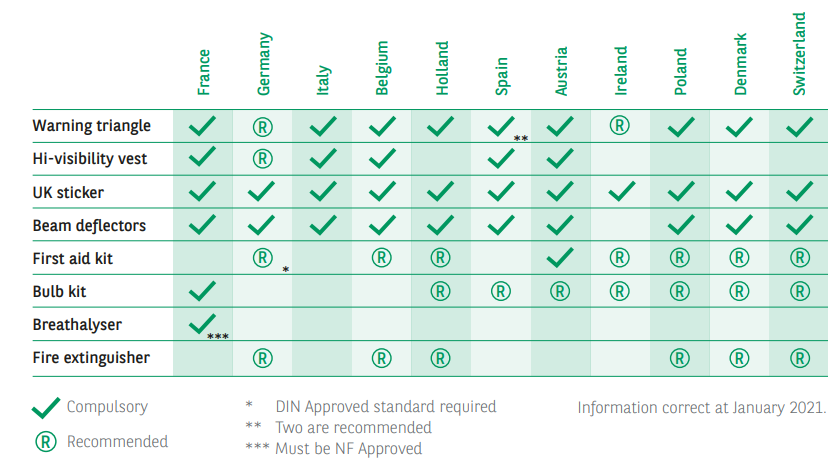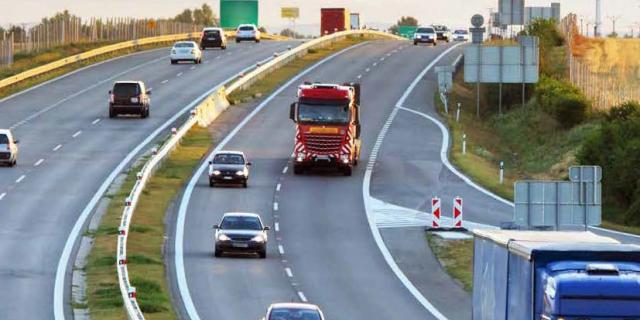Driving in Europe
If you are planning to take your Arval car overseas this summer for holidays, or work trips, here are a few things you should know before you leave.
It’s important to remember that each country’s motoring laws, regulations and advice are subject to constant review, change and differing interpretations. Before setting off on any trip abroad, please make sure you’re familiar with the laws which may affect your journey (including any countries you travel through).
Your Arval car should be well maintained and regular serviced anyway, but you might like to ensure that all required maintenance and any planned servicing is up to date before you travel. This will reduce the chance of expensive breakdowns when abroad.
The enforcement of motoring laws abroad can be more severe than in the UK. Very large on the spot fines can be imposed in some countries, so make sure that you comply with sign posted speed limits and that everyone in the car is wearing a seat belt. There are a number of important steps before taking your vehicle abroad, as well as equipment to take and rules to be aware of.
Visit: www.theaa.com/european-breakdown-cover/driving-in-europe for the latest information.
Documents you will need
You may be asked to produce the following documents at any time. To avoid a police fine and/or confiscation of your vehicle, be sure that they are readily available for inspection.
- A valid full driving licence (not provisional)
- Vehicle on Hire Certificate (VE103) (add link to the Arval service)
- Your passport
- UK Sticker - after 28 September 2021, you will need to display a UK sticker clearly on the rear of your vehicle if your number plate has any of the following:
- a GB identifier with the Union flag (also known as the Union Jack)
- a Euro symbol
- a national flag of England, Scotland or Wales
- numbers and letters only
- no flag or identifier
- If your number plate includes the UK identifier with the Union flag (also known as the Union Jack), you do not need a UK sticker.
- If you’re in Spain, Cyprus or Malta, you must display a UK sticker no matter what is on your number plate.
- If you have a GB sticker, cover or remove it.
- An International Driving Permit when necessary
- Please check here whether you need one: www.gov.uk/driving-abroad/international-driving-permit
Obtaining your VE103 from Arval
If you are a driver of an Arval vehicle, where it is leased from Arval, we are the registered keeper. This means that you WILL need a VE103 document, the recognised legal alternative to the registration document, to take the vehicle outside the UK.
This document must be the original version, not a photocopy. This also covers you whilst proceeding to, and returning from, the port of embarkation. It is valid for a year from the date of issue and will cover you for all your foreign travel within that year.
There is a charge of £15.00 + VAT per certificate. The address used for the VE103 must legally be the ‘custodians’ home address and must match the address on your driving licence.
Drivers of Arval cars can now request a VE103 online - VE103 Travelling Abroad Request Pack | Arval Vehicle Leasing - please aim to contact us at least 5 working days prior to travel.
Equipment and preparing your vehicle
When travelling in Europe, you must ensure that you comply with European motoring regulations by carrying the following items of equipment, which are required by law in many countries and are advisable in any case.
Headlights
If you are driving in Europe, you must adjust the headlamp beam pattern to suit driving on the right so that the dipped beam will not dazzle oncoming drivers. Never go without adjusting the headlamp pattern, as it is a compulsory requirement in most countries and not doing so can invalidate your insurance.
Tyres
Like the UK, most countries require a minimum tread depth of 1.6mm over the central three-quarters of the tread and around the whole circumference of the tyre. Arval recommends a minimum of 2mm, but consider changing tyres if the tread is down to 3mm before you travel.
Overloading
Overloading your vehicle can incur fines and possibly invalidate insurance, as well as the potential safety risks. Overloading can cause damage to suspension, burnt out clutch, punctures or uneven wear on tyres.
Safety items
The legally required safety items vary depending on which country you’re traveling to.

Crit’Air sticker (France)
In some areas of France, low emission zones are being introduced to restrict vehicle access. In order to drive through these areas without penalty, you’ll need to display a “Vignette” (sticker) on your vehicle.
Driving in France and Monaco | AA (theaa.com)
Order a Sticker - Home page | Official website for the Crit'Air sticker (certificat-air.gouv.fr)
Warning triangle
These are compulsory in the majority of countries to give advance warning of a hazard on the road. Hazard warning lights alone are NOT sufficient in many European countries.
Speed-trap detection devices
The use or possession of devices to detect police radar is illegal in most European countries. Penalties can include a fine, driving ban and even imprisonment.
We’ve pulled together a handy guide covering a number of important steps to take before taking your vehicle abroad such as:
> Documents you need
> Equipment and preparing your vehicle
> Advice for drivers and passengers
Read the full guide here.




